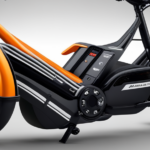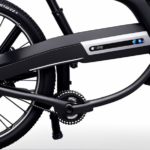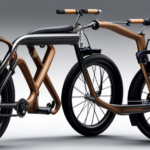I know what you’re thinking – why do I need to understand how American electric bike batteries are wired? Well, let me tell you, my friend, it’s all about unlocking the true power of these incredible machines.
In this article, I will delve into the technical details of electric bike battery wiring, exploring the basic components, voltage and capacity considerations, wiring configurations, and even legal regulations.
So buckle up, because we’re about to take a deep dive into the fascinating world of electric bike battery wiring.
Key Takeaways
- American electric bike batteries can be wired in series or parallel configurations, depending on the desired voltage and capacity.
- The correct wiring and battery connectors are crucial for proper insulation, polarity, and secure connections, ensuring optimal performance and longevity of the battery.
- Proper charging methods, avoiding overcharging and extreme temperatures, can help extend the lifespan of American electric bike batteries.
- Regular maintenance, monitoring, and following safety guidelines and instructions from manufacturers are important for maximizing battery lifespan and ensuring safety.
Basic Components of an Electric Bike Battery
The basic components of an electric bike battery include the cells, the BMS, and the casing. The cells are the heart of the battery, where the chemical reactions take place to store and release energy. These cells are typically lithium-ion, as they offer high energy density and long cycle life.
The BMS, or Battery Management System, is responsible for monitoring and controlling the battery’s performance and safety. It regulates the charging and discharging process, ensuring that the battery operates within safe limits. The BMS also protects against overcharging, overdischarging, and overheating.
When it comes to battery charging methods, there are several options available. The most common method is using a standard charger that plugs into a wall outlet. This charger typically takes around 4-6 hours to fully charge the battery. Another option is using a fast charger, which can charge the battery in 2-3 hours but may require a higher voltage power supply. Additionally, some electric bikes have the capability to charge the battery while riding, known as regenerative braking. This feature converts kinetic energy into electrical energy and stores it back into the battery.
Understanding battery voltage and capacity is crucial for getting the most out of your electric bike. Battery voltage is measured in volts (V) and determines the power output of the battery. Higher voltage batteries provide more power and acceleration. Battery capacity, on the other hand, is measured in ampere-hours (Ah) and determines the range or distance that can be covered on a single charge. Higher capacity batteries can deliver more energy and allow for longer rides.
Understanding Battery Voltage and Capacity
Understanding battery voltage and capacity is crucial when it comes to electric bikes. The voltage of a battery determines the power it can deliver, while the capacity refers to the amount of energy it can store. These two factors play a significant role in determining the range and performance of an electric bike. To better comprehend the concept, let’s take a look at the following table:
| Battery Voltage (V) | Battery Capacity (Ah) | Maximum Range (miles) |
|---|---|---|
| 36 | 10 | 30 |
| 48 | 15 | 45 |
| 52 | 20 | 60 |
| 72 | 25 | 75 |
As shown in the table, higher voltage and capacity values result in increased range capabilities. However, it is important to note that battery charging methods and maximizing battery lifespan should also be considered. Using appropriate charging methods, such as avoiding overcharging or discharging the battery completely, can help extend its lifespan. Additionally, implementing strategies like using the battery within its recommended voltage range and avoiding extreme temperatures can also contribute to maximizing battery longevity.
Transitioning into the subsequent section about ‘series vs parallel wiring configurations,’ it is essential to understand how these wiring configurations impact the overall performance of an electric bike.
Series vs Parallel Wiring Configurations
To compare series and parallel wiring configurations, it’s important to consider how they affect the performance of an e-bike.
In series wiring, the batteries are connected end to end, creating a single, longer power source. This configuration increases the voltage while maintaining the same capacity. One advantage of series wiring is that it allows for higher top speeds and better hill climbing capabilities. However, one disadvantage is that if one battery fails or gets depleted, it affects the entire system.
On the other hand, in parallel wiring, the batteries are connected side by side, increasing the overall capacity while maintaining the same voltage. This configuration allows for longer ride times and increased range. Additionally, if one battery fails, the others can still provide power, ensuring the bike remains operational. However, one disadvantage is that the top speed and hill climbing capabilities may be slightly reduced compared to series wiring.
The correct wiring configuration is crucial for optimal e-bike performance. Whether you choose series or parallel wiring depends on your specific needs and preferences. The importance of correct wiring cannot be overstated as it directly impacts the overall performance and capabilities of an e-bike.
Importance of Correct Wiring
Remember, choosing the correct wiring configuration for your e-bike is essential to ensure optimal performance. When it comes to battery wiring techniques, there are some common mistakes that can easily be avoided. Here are four important points to keep in mind:
-
Proper Insulation: One of the most crucial steps in wiring your e-bike battery is ensuring that all connections are properly insulated. This not only protects the wires from damage but also prevents any short circuits or electrical hazards.
-
Correct Polarity: Another common error is wiring the battery with incorrect polarity. It’s important to connect the positive terminal of the battery to the positive terminal of the controller, and the negative terminal to the negative terminal. Reversing the polarity can lead to damage or malfunction of the electrical components.
-
Secure Connections: It is imperative to make sure that all connections are securely fastened. Loose or weak connections can lead to power loss, overheating, or even electrical arcing.
-
Appropriate Gauge Wire: Choosing the right gauge wire is essential for efficient power transfer. Using wire that is too thin can result in high resistance, which can lead to power loss and decreased performance.
By following these correct battery wiring techniques and avoiding common wiring mistakes, you can ensure the optimal performance and longevity of your e-bike battery.
Now, let’s move on to the different types of battery connectors.
Different Types of Battery Connectors
Now let’s explore the various types of connectors used for e-bike batteries.
There are several types of battery connectors available in the market today, each with its own set of advantages and disadvantages.
One common type is the Anderson Powerpole connector, which is known for its high current carrying capacity and secure connection. It is easy to use and has a genderless design, allowing for quick and hassle-free assembly.
Another popular option is the XT60 connector, which is widely used in the RC hobby industry. It provides a reliable connection and is capable of handling high currents. However, it can be a bit challenging to connect and disconnect due to its tight fit.
The XT90 connector is similar to the XT60 but has a higher current rating and is more suitable for larger battery packs. On the downside, it is bulkier and may not fit in tight spaces.
Finally, the bullet connector is a simple and cost-effective option. It is compact and easy to install but may not offer the same level of reliability as other connectors.
Moving on to the next section about wiring diagrams for common battery configurations, we can see how these connectors are integrated into the overall system.
Wiring Diagrams for Common Battery Configurations
When it comes to wiring batteries for electric bikes, there are several common configurations to consider. These include 36V, 48V, and 72V setups, each with their own unique wiring diagrams.
In this discussion, we will delve into the technical details of these battery wiring configurations, exploring the connections and components involved in each setup.
36V Battery Wiring
The V battery wiring determines the power distribution in American electric bike batteries. Proper battery maintenance and charging techniques are crucial for optimal performance and longevity.
When it comes to battery maintenance, regular inspections should be conducted to ensure that the connections are secure and free of corrosion. Additionally, keeping the battery clean and dry can help prevent any potential issues.
When it comes to charging, it is important to follow the manufacturer’s guidelines and use the appropriate charger. Overcharging can lead to battery damage, while undercharging can result in reduced battery capacity. It is also recommended to avoid charging the battery in extreme temperatures, as it can affect its overall performance.
Understanding the importance of battery maintenance and employing the correct charging techniques is essential for ensuring the longevity and efficiency of American electric bike batteries.
Next, let’s delve into the intricacies of V battery wiring.
48V Battery Wiring
To ensure optimal performance and longevity of your V battery, it’s crucial to understand and properly maintain the wiring configuration. The voltage drop across the wiring can greatly affect battery charging and overall efficiency. Here are three important factors to consider:
-
Wire Gauge: Choosing the appropriate wire gauge is vital to minimize voltage drop. Thicker wires have lower resistance, reducing the voltage drop and maximizing the charging efficiency.
-
Wire Length: The longer the wire, the greater the voltage drop. Keeping the wire length as short as possible minimizes the resistance and ensures efficient battery charging.
-
Connection Quality: Ensuring secure and clean connections between wires and battery terminals is essential. Loose or corroded connections can increase the resistance, leading to a higher voltage drop and decreased charging efficiency.
Understanding these factors will help you maintain an optimal wiring configuration for your V battery, ensuring smooth battery charging and maximizing its performance.
Now let’s delve into the details of V battery wiring configuration.
72V Battery Wiring
Understanding the factors mentioned earlier will help you maintain an optimal wiring configuration for your V battery. When it comes to battery charging and maintenance, there are a few key considerations to keep in mind. First, it is important to ensure that your battery is charged properly to avoid overcharging or undercharging. This can be achieved by using a compatible charger and following the manufacturer’s guidelines. Additionally, regular battery maintenance is crucial for its longevity. This includes keeping the battery clean and free from corrosion, checking the electrolyte levels if applicable, and inspecting for any damages or leaks. By following these steps, you can ensure that your V battery remains in good condition and performs optimally. Moving on to the next section about tips for proper battery wiring installation…
| Factors to Consider | Benefits |
|---|---|
| Using a compatible charger | Prevents overcharging or undercharging |
| Following manufacturer’s guidelines | Ensures proper charging |
| Regular battery maintenance | Increases battery lifespan |
| Keeping the battery clean | Prevents corrosion |
| Checking electrolyte levels | Maintains optimal performance |
| Inspecting for damages or leaks | Identifies issues early on |
Tips for Proper Battery Wiring Installation
For proper battery wiring installation, it’s important to follow these tips.
-
Use the right gauge wire: Choosing the correct wire gauge is crucial for efficient power transmission and preventing overheating. Consult the manufacturer’s guidelines or a professional to determine the appropriate wire size for your battery.
-
Ensure tight connections: Loose connections can lead to voltage drops, which can reduce battery performance. Make sure all connections are secure and free from corrosion.
-
Protect the wiring: To prevent damage to the wiring and ensure longevity, use protective conduit or tubing to shield it from potential hazards such as sharp edges or heat sources.
-
Implement proper grounding: Grounding is essential for safety and proper operation. Connect the negative terminal of the battery to a reliable grounding point on the vehicle or equipment.
Proper battery wiring installation and maintenance are key to extending battery life and maximizing performance. By following these tips, you can ensure a reliable and efficient power supply.
However, even with proper installation, battery wiring issues can still arise. It’s important to be aware of common problems and know how to troubleshoot them effectively.
Troubleshooting Common Battery Wiring Issues
Check if there are any loose connections or corroded wires, as these common battery wiring issues can affect the performance of your electrical system. Troubleshooting battery wiring problems is crucial for maintaining the optimal functioning of your electric bike. Below, I have provided a table outlining some of the most common battery wiring mistakes and their potential impact on your electric bike’s performance:
| Common Battery Wiring Mistakes | Impact on Electrical System |
|---|---|
| Loose connections | Intermittent power supply |
| Corroded wires | Reduced power output |
| Incorrect gauge wire | Overheating and damage |
| Poor insulation | Short circuits |
Identifying and resolving these issues is essential to ensure the longevity and efficiency of your electric bike. Loose connections can lead to intermittent power supply, causing your bike to suddenly lose power. Corroded wires can reduce the power output, limiting the performance of your electric bike. Using the incorrect gauge wire can result in overheating and potential damage to the battery. Poor insulation can lead to short circuits, posing a safety risk.
Maintaining and Caring for Your Electric Bike Battery
Now let’s talk about how to properly maintain and care for your e-bike battery. Taking care of your battery is essential to ensure its longevity and optimal performance. Here are some important tips to follow:
-
Use the right charger: Always use the charger that is specifically designed for your e-bike battery. Using the wrong charger can damage the battery and reduce its lifespan.
-
Avoid overcharging: Overcharging can cause the battery to overheat, which can lead to decreased performance and even permanent damage. Be sure to unplug the charger once the battery is fully charged.
-
Store in a cool, dry place: Extreme temperatures can negatively affect your battery’s lifespan. Store it in a cool, dry place, away from direct sunlight and moisture.
-
Regularly charge your battery: Keeping your battery charged is crucial for its overall health. Even if you’re not using your e-bike regularly, it’s recommended to charge the battery at least once every few weeks.
-
Maintain proper battery levels: Aim to keep your battery between 20-80% charged. Charging it to full capacity or letting it completely drain can put unnecessary stress on the battery.
By following these battery charging techniques and extending battery lifespan, you can ensure that your e-bike battery remains in excellent condition.
Now, let’s explore the next topic, which is upgrading or replacing your electric bike battery.
Upgrading or Replacing Your Electric Bike Battery
When considering upgrading or replacing your electric bike battery, there are several compatibility considerations to keep in mind.
It is crucial to ensure that the new battery is compatible with your electric bike model and its electrical system. Additionally, you should take into account the battery’s voltage, capacity, and physical dimensions to ensure a proper fit.
In terms of battery upgrade options, you may have the choice to upgrade to a higher capacity battery for extended range or switch to a different battery chemistry for improved performance.
Lastly, when disposing of your old battery, it is important to recycle it responsibly to minimize its environmental impact and potentially even receive a credit towards the purchase of a new battery.
Compatibility Considerations
Make sure you’re aware of the compatibility considerations when it comes to wiring American electric bike batteries. Proper wiring is crucial to ensure the safe and efficient operation of your electric bike.
When connecting a new battery, it is important to check if it is compatible with your bike’s charging system. Different battery models may require different charging methods, so it is essential to follow the manufacturer’s guidelines.
Additionally, consider the battery lifespan and maintenance. Regularly check the battery voltage and ensure it is within the recommended range. Proper maintenance, such as cleaning the battery terminals and protecting it from extreme temperatures, can help extend its lifespan.
Now that you understand the compatibility considerations, let’s explore the various battery upgrade options available for your electric bike.
Battery Upgrade Options
If you’re looking to upgrade your electric bike’s battery, there are several options available. One option is to increase the battery capacity, which will allow for a longer battery range. This can be done by replacing the current battery with one that has a higher capacity.
Another option is to extend the battery range by adding an external battery pack. This pack can be attached to the bike and connected to the existing battery, providing additional power and extending the range.
Additionally, some electric bike manufacturers offer upgrade kits that allow you to upgrade the battery capacity and range of your bike. These kits typically include a new battery, charger, and any necessary wiring or connectors.
By upgrading your electric bike’s battery, you can enjoy longer rides and have more flexibility in your cycling adventures.
When it comes to upgrading your electric bike’s battery, it’s important to consider what to do with the old battery. Recycling old batteries is crucial for environmental sustainability. Instead of disposing of the old battery in the trash, it should be taken to a designated recycling facility.
These facilities have the proper equipment and processes to safely recycle the batteries and recover valuable materials. Recycling old batteries helps reduce the environmental impact caused by battery disposal and promotes the reuse of valuable resources.
Recycling Old Batteries
Recycling old batteries is essential for reducing environmental impact and promoting resource reuse. Battery recycling is a critical process that aims to recover valuable materials from used batteries while minimizing the negative effects on the environment.
When batteries are not properly recycled, they can release toxic chemicals and heavy metals into the soil and water, posing significant risks to human health and the ecosystem. By recycling batteries, we can prevent these hazardous materials from contaminating our environment and conserve valuable resources such as lithium, cobalt, and nickel. Additionally, battery recycling reduces the need for mining raw materials, reducing the associated environmental impact.
Transitioning to the next section, it is equally important to emphasize safety precautions when working with electric bike batteries, as mishandling them can lead to serious accidents.
Safety Precautions When Working with Electric Bike Batteries
When it comes to working with electric bike batteries, it is crucial to prioritize proper handling and storage procedures. This includes securely fastening the battery to the bike frame and ensuring it is protected from extreme temperatures and moisture.
Additionally, it is essential to take precautions to avoid electric shocks, such as wearing insulated gloves and using insulated tools while working with the battery.
Lastly, knowing how to deal with battery fires is crucial in case of emergencies. This includes having a fire extinguisher nearby and knowing how to safely disconnect and remove the battery from the bike if necessary.
Proper Handling and Storage
To properly handle and store your American electric bike battery, make sure you follow the manufacturer’s guidelines. It is important to ensure that the battery is stored in a suitable environment with the proper storage temperature. Extreme temperatures, both hot and cold, can have a negative impact on the battery’s performance and lifespan. Additionally, there are certain handling precautions that should be taken to ensure the safety of both the battery and the user. Avoid dropping or mishandling the battery, as this can cause damage to the internal components. It is also important to avoid exposing the battery to water or other liquids, as this can lead to corrosion and potential malfunctions. By following these guidelines, you can ensure the longevity and safety of your electric bike battery.
| Proper Storage Temperature | Handling Precautions |
|---|---|
| Avoid extreme temperatures | Do not drop or mishandle the battery |
| Store in a cool, dry place | Keep away from water or other liquids |
| Ideal temperature range: 20-25°C (68-77°F) | Follow manufacturer’s instructions for safe handling |
| Avoid direct sunlight | Use protective gear when handling the battery |
When it comes to handling and storing your electric bike battery, it is crucial to prioritize safety. By adhering to the proper storage temperature and following handling precautions, you can minimize the risk of accidents or damage. However, it is also important to be aware of another potential hazard – electric shocks.
Avoiding Electric Shocks
Now that we have discussed the proper handling and storage of electric bike batteries, let’s move on to another crucial aspect of battery safety: avoiding electric shocks.
As an electric bike enthusiast, it is essential to understand the potential risks and take necessary precautions to prevent electrical accidents. Here are some safety guidelines for electric bike batteries:
- Always wear insulated gloves and safety goggles when working with batteries.
- Ensure that the battery is disconnected from the bike before performing any maintenance tasks.
- Regularly inspect the battery for any signs of damage or wear, such as frayed wires or leaking electrolyte.
By following these safety guidelines, you can minimize the risk of electric shocks and ensure a safer experience with your electric bike.
Now, let’s transition into the subsequent section about dealing with battery fires, where we will explore the necessary steps to handle such emergencies effectively.
Dealing with Battery Fires
If a battery fire occurs, it’s important to remember to never use water to extinguish it. Water can react with the chemicals in the battery and potentially make the fire worse. Instead, it is recommended to use a Class D fire extinguisher specifically designed for lithium-ion battery fires. These extinguishers contain a dry powder that can smother the fire and prevent it from spreading.
Additionally, when dealing with battery leaks, it’s crucial to wear protective gloves and goggles to avoid direct contact with the leaked material, which may be corrosive or toxic.
To prevent battery overheating, it is essential to store and charge the batteries in a cool and well-ventilated area. Following these precautions can help mitigate the risks associated with battery fires and leaks, ensuring the safe operation of electric bike batteries.
Moving forward, let’s now discuss the regulations and legal considerations for electric bike batteries.
Regulations and Legal Considerations for Electric Bike Batteries
When it comes to electric bike batteries, there are several important regulations and legal considerations to keep in mind.
First and foremost are the battery transportation regulations, which dictate how these batteries should be handled and transported safely.
Additionally, there are battery disposal regulations that outline the proper procedures for disposing of these batteries to minimize environmental impact.
Lastly, battery safety standards are crucial to ensure that these batteries are manufactured and designed with the highest level of safety in mind, protecting both users and the environment.
Battery Transportation Regulations
To ensure compliance with battery transportation regulations, it is crucial to be aware of the specific requirements for handling and transporting American electric bike batteries.
When it comes to battery storage solutions, keep the batteries in a cool, dry place that is well-ventilated. This will help prevent any potential damage or overheating.
Additionally, when charging the batteries, use the correct charging techniques. Follow the manufacturer’s guidelines and use a charger specifically designed for electric bike batteries. This will help prolong the battery life and ensure safe charging.
Lastly, adhere to the proper guidelines for battery disposal regulations to protect the environment. Dispose of batteries at designated recycling centers or follow the local regulations for battery disposal.
Battery Disposal Regulations
To comply with battery disposal regulations, it is crucial to dispose of electric bike batteries at designated recycling centers or follow local regulations. Proper battery disposal minimizes the environmental impact of battery waste. There are several methods available for battery disposal, including recycling, reusing, and proper disposal in accordance with local regulations.
Recycling centers are equipped to handle electric bike batteries and recover valuable materials like lithium and other metals. This reduces the need for new raw materials, conserves resources, and minimizes the environmental impact of battery disposal. By following proper battery disposal methods, we can contribute to a more sustainable future.
Transitioning into the subsequent section about ‘battery safety standards,’ it is important to understand the importance of handling batteries safely to prevent accidents and ensure their proper functioning.
Battery Safety Standards
After understanding the regulations regarding battery disposal, it is crucial to delve into the topic of battery safety standards. Electric bike batteries are not only responsible for powering the bike but also require proper handling and care to ensure longevity and safety.
There are various battery charging methods available, such as trickle charging, fast charging, and smart charging, each with its advantages and limitations. These methods impact the battery lifespan and overall performance. It is essential to follow the manufacturer’s guidelines and recommendations for charging to prevent overcharging or undercharging, which can lead to reduced battery capacity and premature battery failure.
Additionally, battery safety standards encompass various aspects, including thermal management, overcurrent protection, and proper insulation. Adhering to these standards ensures a safe and efficient battery system.
Now, let us explore future developments in electric bike battery wiring.
Future Developments in Electric Bike Battery Wiring
As we look towards the future of electric bike battery wiring, there are several key areas of development that are worth exploring.
Advances in battery technology have led to increased energy storage capacity and longer cycling life, allowing for more efficient and reliable electric bike systems.
Wireless charging technology is also showing promise, eliminating the need for physical connections and enabling convenient charging options.
Additionally, smart battery management systems are becoming more sophisticated, allowing for better monitoring and optimization of battery performance, ensuring optimal power delivery and prolonging battery lifespan.
Advances in Battery Technology
You’ll be amazed at the recent advances in battery technology for American electric bikes. These advancements have greatly improved the wireless charging efficiency, allowing for faster and more convenient charging of electric bike batteries. The impact on battery lifespan is also significant, as the new technology minimizes the heat generated during charging, reducing the wear and tear on the battery cells.
Here are some noteworthy developments in battery technology:
- Lithium-ion batteries with higher energy density, providing longer range and improved performance.
- Advanced battery management systems that optimize the charging process, ensuring efficient use of power and extending battery life.
- Smart battery technology that enables real-time monitoring of battery health, allowing riders to make informed decisions about charging and usage.
- Integration of regenerative braking systems, which capture and store energy during braking, further enhancing the overall efficiency of electric bikes.
With these advancements in battery technology, the future of electric bikes looks promising. Now, let’s delve into the exciting world of wireless charging technology.
Wireless Charging Technology
To experience the convenience of wireless charging, simply place your electric bike on the charging pad and watch as the battery powers up without the need for any cords or cables.
Wireless charging technology has made significant advancements in recent years, improving both its efficiency and impact on battery lifespan.
The efficiency of wireless charging refers to how effectively it transfers power to the battery. With advancements in technology, wireless chargers have become more efficient, minimizing energy loss during the charging process. This not only speeds up the charging time but also reduces the energy consumption.
Moreover, wireless charging has been designed to ensure that it does not have a negative impact on the battery lifespan. The charging process is carefully managed to prevent overcharging or overheating, which can lead to premature degradation of the battery.
As we delve further into the topic of electric bike batteries, it is important to also consider the role of smart battery management systems in optimizing battery performance and longevity.
Smart Battery Management Systems
Now that we have explored the possibilities of wireless charging technology for electric bike batteries, let’s dive into the world of smart battery management systems.
These systems play a crucial role in optimizing the charging process and extending the overall lifespan of the battery.
Smart battery management systems are designed to monitor and control the charging process of electric bike batteries. They utilize advanced battery management software to regulate the voltage and current during charging, ensuring a safe and efficient process. This software provides real-time information about the battery’s state of charge, allowing users to track its performance and make informed decisions.
By implementing smart battery management systems, electric bike owners can choose from various battery charging methods such as trickle charging, fast charging, or balance charging. These methods help optimize the battery’s charging process, preventing overcharging or undercharging, which can lead to reduced battery life.
Now that we have explored the importance of smart battery management systems and battery charging methods, let’s move on to addressing some frequently asked questions about electric bike battery wiring.
Frequently Asked Questions about Electric Bike Battery Wiring
One common question is: ‘How are American electric bike batteries wired?’
When it comes to electric bike battery wiring, there are a few key factors to consider. Firstly, battery charging techniques play a crucial role in maintaining the longevity and performance of the battery. It is important to follow the manufacturer’s instructions for charging, which may include specific voltage and current requirements. Additionally, it is advisable to use a charger that is specifically designed for electric bike batteries, as using the wrong charger can damage the battery or even pose a safety risk.
Another important aspect of electric bike battery wiring is avoiding common wiring mistakes. One common mistake is incorrectly connecting the positive and negative terminals, which can result in short-circuiting the battery and potentially damaging the entire electrical system. It is essential to double-check the connections and ensure that the positive terminal is connected to the positive wire, and the negative terminal is connected to the negative wire.
Conclusion: Unlocking the Power of Electric Bike Battery Wiring
Understanding the correct techniques for charging and avoiding common wiring mistakes is essential for maximizing the performance and safety of electric bike batteries.
When it comes to battery charging techniques, there are a few key points to keep in mind. First, always use the charger that is specifically designed for your electric bike battery. Using a charger that is not compatible can lead to overcharging or undercharging, which can shorten the battery’s lifespan. Additionally, it is important to charge the battery fully before each use to optimize its range.
To further optimize battery range, it is crucial to avoid common wiring mistakes. One common mistake is using incorrect wire gauge. Using wires that are too thin can result in voltage drops and inefficient charging. It is recommended to consult the manufacturer’s guidelines to determine the appropriate wire gauge for your electric bike battery. Another mistake to avoid is improper insulation. Exposed wires can lead to short circuits and potential accidents. Always ensure that the wires are properly insulated and protected.
Frequently Asked Questions
Can I use a higher voltage battery on my electric bike?
Using a higher voltage battery on an electric bike can have pros and cons. It can enhance performance by providing more power, but it may also put stress on the motor and other components, affecting their lifespan. Safety precautions should be taken to prevent overloading or overheating.
How do I know if my battery is wired in series or parallel?
To determine if a battery is wired in series or parallel, inspect the connections. In series wiring, positive terminals connect to negative terminals, creating a chain. In parallel wiring, positive terminals connect to positive terminals and negative to negative. Troubleshooting involves checking for loose or damaged connections.
What should I do if I notice a loose connection in my battery wiring?
If I notice a loose connection in my battery wiring, I would start by turning off the power and carefully inspecting the wiring for any damaged or loose connections. Then, I would repair or replace any faulty components to ensure proper functioning of the battery. Troubleshooting battery wiring requires attention to detail and precision.
Can I use different types of battery connectors on my electric bike battery?
Yes, you can use different types of battery connectors on your electric bike battery. However, it is important to ensure compatibility and proper wiring to avoid damage. Regular maintenance is also crucial for optimal performance and longevity of electric bike batteries.
Are there any regulations or legal considerations I should be aware of when it comes to electric bike battery wiring?
When it comes to electric bike battery wiring, there are regulations on battery capacity and safety considerations that must be followed. It is important to ensure that the wiring is done correctly to prevent any potential hazards.
Conclusion
So there you have it, folks! After diving deep into the intricacies of American electric bike battery wiring, we’ve uncovered the secrets behind unlocking the true power of these batteries.
From understanding the basic components to exploring series vs parallel wiring configurations, we’ve covered it all.
And let’s not forget about the importance of correct wiring and the different types of battery connectors.
But hey, don’t forget about the regulations and legal considerations too!
As we wrap up, just remember that the future holds exciting developments in electric bike battery wiring. So go out there, ride with confidence, and embrace the electrifying world of e-bikes!
















